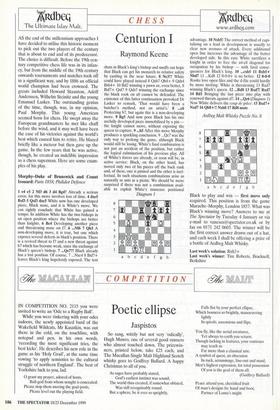Centurion I
Raymond Keene
AS the end of the millennium approaches I have decided to utilise this historic moment to pick out the two players of the century that is about to end and of its predecessor. The choice is difficult. Before the 19th cen- tury competitive chess life was in its infan- cy, but from the middle of the 19th century onwards tournaments and matches took off in a significant way, and by 1886 an official world champion had been crowned. The greats included Howard Staunton, Adolf Anderssen, Wilhelm Steinitz and the young Emanuel Lasker. The outstanding genius of the time, though, was, in my opinion, Paul Morphy. This young American seemed born for chess. He swept away the European grandmasters he met like chaff before the wind, and it may well have been the ease of his victories against the world's best which caused him to retire. He blazed briefly like a meteor but then gave up the game. In the few years that he was active, though, he created an indelible impression as a chess superman. Here are some exam- ples of his play.
Morphy-Duke of Brunswick and Count Isouard: Paris 1858; Philidor Defence
1 04 e5 2 ND d6 3 d4 B84? Already a serious error, for this move involves loss of time. 4 dxe5 Bxf3 5 Qicf3 dxe5 White now has one developed piece, Black none, and it is White's move. We can rightly conclude that White has gained a tempo. In addition White has the two bishops in an open position where the bishops are better than knights. 6 Bc4 Developing another piece and threatening mate on f7. 6 ...Nf6 7 Qb3 A non-developing move, it is true, but one which exposes several defects in black's position. There is a revived threat to 17 and a new threat against b7 which has become weak, since the exchange of Black's queen's bishop. 7 ...Qe7?! Black already has a lost position. Of course, 7 ...Nxe4 8 Bizt7+ leaves Black's king hopelessly exposed. The text shuts in Black's king's bishop and snuffs out hope that Black can get his monarch to relative safety by castling in the near future. 8 Nc31? White could have played instead 8 Qxb7 Qb4+ 9 Qxb4 13xb4+ 10 Bd2 winning a pawn or, even better, 8 Bicf7+ Qxf7 9 Qx117 winning the exchange since the black rook on a8 cannot be defended. The existence of this latter continuation provoked Dr Lasker to remark, 'That would have been a butcher's method, not an artist's.' 8 -.c6 Protecting b7, but again this is a non-developing move. 9 Bg5 And now poor Black has his one usefully developed piece immobilised by a pin — the knight cannot move, without exposing the queen to capture. 9 .-b5 After this move Morphy produces a sparkling conclusion. 9 ...0c7 was the only way to prolong the game, although Black would still be losing. White's final combination is not just an accident of the position, but rather the logical culmination of his previous play. All of White's forces are already, or soon will be, in active service: Black, on the other hand, has moved only two of his pieces off the back rank and, of these, one is pinned and the other is inef- fectual. In such situations combinations arise as naturally as ants at a picnic. We should be more surprised if there was not a combination avail- able to exploit White's immense positional
Diagram 1
advan age. 10 Nxb5! The correct method of capi Wising on a lead in development is usually to clear new avenues of attack. Every additions open line increases the advantage of the better developed side. In this case White sacrifices a knight in order to free the a4-e8 diagonal for occupation by his bishop — with fatal conse- quences for Black's king. 10 ...ocb5 11 Bxb5+ Nbd7 11 ...Kd8 12 0-0-0+ is no better 12 0-0-0 Rooks love open files and the d-file could hardly be more inviting. White is threatening 13 Rxd7 winning Black's queen. 12 ...Rd8 13 Rxd71 Rxd7 14 Rdl Bringing the last piece into play with renewed threats against d7. 14 -.Qe6 (Diagram 1) Now White delivers the coup de grace: 15 Bxd7+ Nxd7 16 Qb8+1! Nxb8 17 Rd8 mate
Ard beg Malt Whisky Puzzle No. 8
Black to play and win — first move only required. This position is from the game Marache-Morphy, London 1857. What was Black's winning move? Answers to me at The Spectator by Tuesday 4 January or via e-mail to vanessa@spectator.co.uk or by fax on 0171 242 0603. The winner will be the first correct answer drawn out of a hat, and each week I shall be offering a prize of a bottle of Ardbeg Malt Whisky.
Last week's solution: Rxh3+
Last week's winner: Tim Roberts, Bracknell, Berkshire






















































































































 Previous page
Previous page